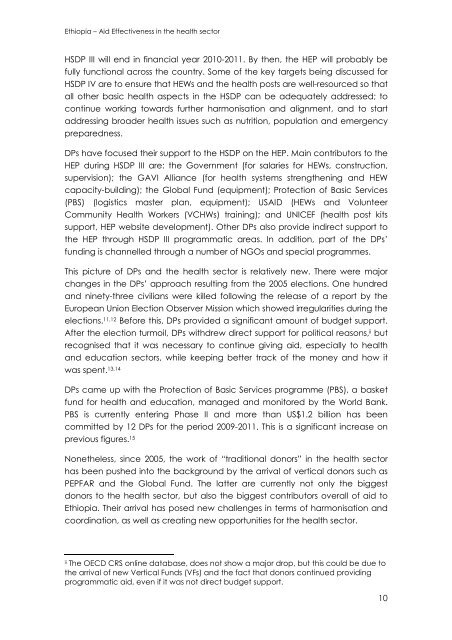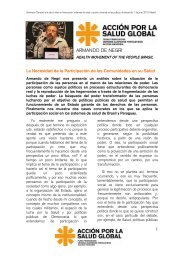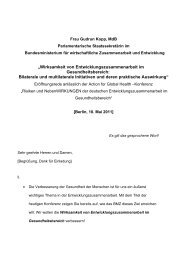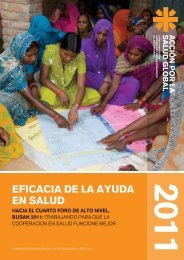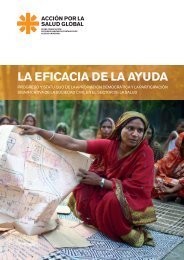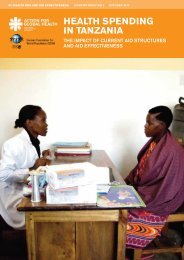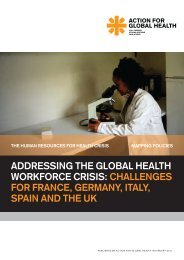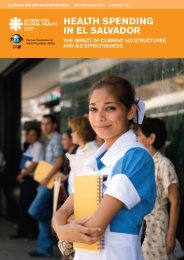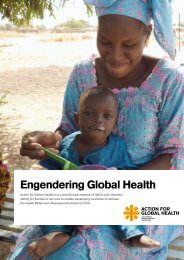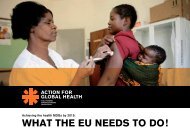Ethiopia Aid effectiveness in the health sector - Action for Global ...
Ethiopia Aid effectiveness in the health sector - Action for Global ...
Ethiopia Aid effectiveness in the health sector - Action for Global ...
Create successful ePaper yourself
Turn your PDF publications into a flip-book with our unique Google optimized e-Paper software.
<strong>Ethiopia</strong> – <strong>Aid</strong> Effectiveness <strong>in</strong> <strong>the</strong> <strong>health</strong> <strong>sector</strong><br />
HSDP III will end <strong>in</strong> f<strong>in</strong>ancial year 2010-2011. By <strong>the</strong>n, <strong>the</strong> HEP will probably be<br />
fully functional across <strong>the</strong> country. Some of <strong>the</strong> key targets be<strong>in</strong>g discussed <strong>for</strong><br />
HSDP IV are to ensure that HEWs and <strong>the</strong> <strong>health</strong> posts are well-resourced so that<br />
all o<strong>the</strong>r basic <strong>health</strong> aspects <strong>in</strong> <strong>the</strong> HSDP can be adequately addressed; to<br />
cont<strong>in</strong>ue work<strong>in</strong>g towards fur<strong>the</strong>r harmonisation and alignment, and to start<br />
address<strong>in</strong>g broader <strong>health</strong> issues such as nutrition, population and emergency<br />
preparedness.<br />
DPs have focused <strong>the</strong>ir support to <strong>the</strong> HSDP on <strong>the</strong> HEP. Ma<strong>in</strong> contributors to <strong>the</strong><br />
HEP dur<strong>in</strong>g HSDP III are: <strong>the</strong> Government (<strong>for</strong> salaries <strong>for</strong> HEWs, construction,<br />
supervision); <strong>the</strong> GAVI Alliance (<strong>for</strong> <strong>health</strong> systems streng<strong>the</strong>n<strong>in</strong>g and HEW<br />
capacity-build<strong>in</strong>g); <strong>the</strong> <strong>Global</strong> Fund (equipment); Protection of Basic Services<br />
(PBS) (logistics master plan, equipment); USAID (HEWs and Volunteer<br />
Community Health Workers (VCHWs) tra<strong>in</strong><strong>in</strong>g); and UNICEF (<strong>health</strong> post kits<br />
support, HEP website development). O<strong>the</strong>r DPs also provide <strong>in</strong>direct support to<br />
<strong>the</strong> HEP through HSDP III programmatic areas. In addition, part of <strong>the</strong> DPs’<br />
fund<strong>in</strong>g is channelled through a number of NGOs and special programmes.<br />
This picture of DPs and <strong>the</strong> <strong>health</strong> <strong>sector</strong> is relatively new. There were major<br />
changes <strong>in</strong> <strong>the</strong> DPs’ approach result<strong>in</strong>g from <strong>the</strong> 2005 elections. One hundred<br />
and n<strong>in</strong>ety-three civilians were killed follow<strong>in</strong>g <strong>the</strong> release of a report by <strong>the</strong><br />
European Union Election Observer Mission which showed irregularities dur<strong>in</strong>g <strong>the</strong><br />
elections. 11,12 Be<strong>for</strong>e this, DPs provided a significant amount of budget support.<br />
After <strong>the</strong> election turmoil, DPs withdrew direct support <strong>for</strong> political reasons, ii but<br />
recognised that it was necessary to cont<strong>in</strong>ue giv<strong>in</strong>g aid, especially to <strong>health</strong><br />
and education <strong>sector</strong>s, while keep<strong>in</strong>g better track of <strong>the</strong> money and how it<br />
was spent. 13,14<br />
DPs came up with <strong>the</strong> Protection of Basic Services programme (PBS), a basket<br />
fund <strong>for</strong> <strong>health</strong> and education, managed and monitored by <strong>the</strong> World Bank.<br />
PBS is currently enter<strong>in</strong>g Phase II and more than US$1.2 billion has been<br />
committed by 12 DPs <strong>for</strong> <strong>the</strong> period 2009-2011. This is a significant <strong>in</strong>crease on<br />
previous figures. 15<br />
None<strong>the</strong>less, s<strong>in</strong>ce 2005, <strong>the</strong> work of “traditional donors” <strong>in</strong> <strong>the</strong> <strong>health</strong> <strong>sector</strong><br />
has been pushed <strong>in</strong>to <strong>the</strong> background by <strong>the</strong> arrival of vertical donors such as<br />
PEPFAR and <strong>the</strong> <strong>Global</strong> Fund. The latter are currently not only <strong>the</strong> biggest<br />
donors to <strong>the</strong> <strong>health</strong> <strong>sector</strong>, but also <strong>the</strong> biggest contributors overall of aid to<br />
<strong>Ethiopia</strong>. Their arrival has posed new challenges <strong>in</strong> terms of harmonisation and<br />
coord<strong>in</strong>ation, as well as creat<strong>in</strong>g new opportunities <strong>for</strong> <strong>the</strong> <strong>health</strong> <strong>sector</strong>.<br />
ii The OECD CRS onl<strong>in</strong>e database, does not show a major drop, but this could be due to<br />
<strong>the</strong> arrival of new Vertical Funds (VFs) and <strong>the</strong> fact that donors cont<strong>in</strong>ued provid<strong>in</strong>g<br />
programmatic aid, even if it was not direct budget support.<br />
10


